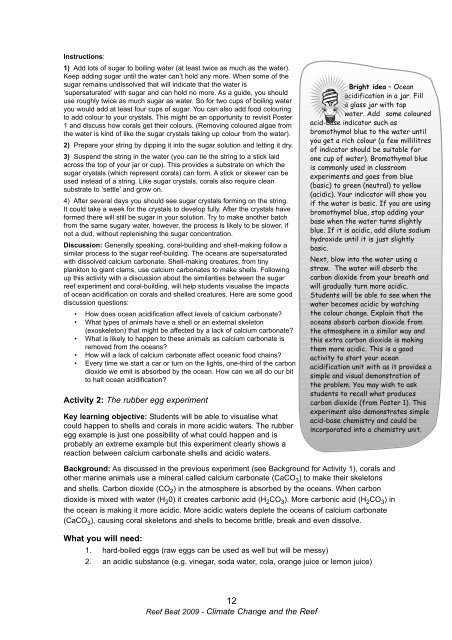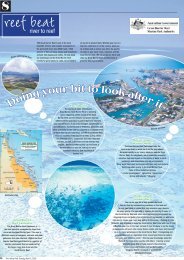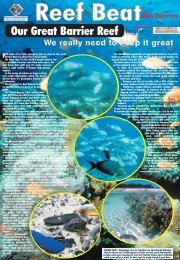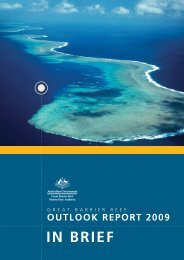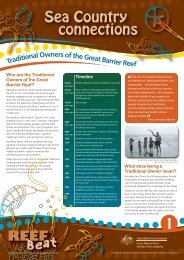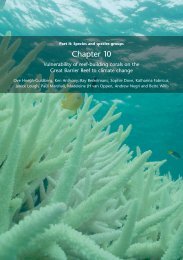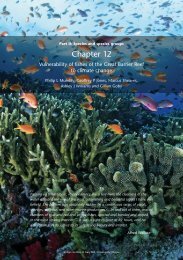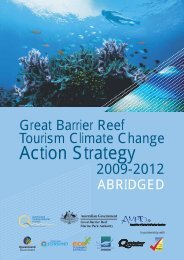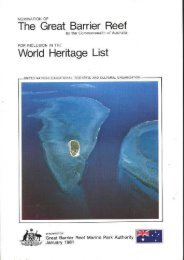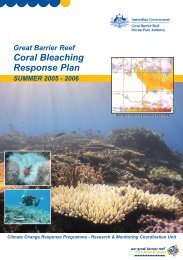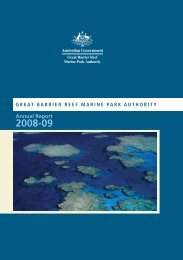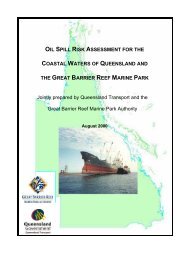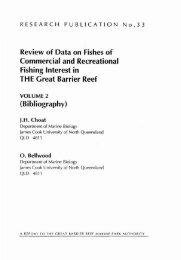ACTIVITIES BOOK - Great Barrier Reef Marine Park Authority
ACTIVITIES BOOK - Great Barrier Reef Marine Park Authority
ACTIVITIES BOOK - Great Barrier Reef Marine Park Authority
Create successful ePaper yourself
Turn your PDF publications into a flip-book with our unique Google optimized e-Paper software.
Instructions:1) Add lots of sugar to boiling water (at least twice as much as the water).Keep adding sugar until the water can’t hold any more. When some of thesugar remains undissolved that will indicate that the water is‘supersaturated’ with sugar and can hold no more. As a guide, you shoulduse roughly twice as much sugar as water. So for two cups of boiling wateryou would add at least four cups of sugar. You can also add food colouringto add colour to your crystals. This might be an opportunity to revisit Poster1 and discuss how corals get their colours. (Removing coloured algae fromthe water is kind of like the sugar crystals taking up colour from the water).2) Prepare your string by dipping it into the sugar solution and letting it dry.3) Suspend the string in the water (you can tie the string to a stick laidacross the top of your jar or cup). This provides a substrate on which thesugar crystals (which represent corals) can form. A stick or skewer can beused instead of a string. Like sugar crystals, corals also require cleansubstrate to ‘settle’ and grow on.4) After several days you should see sugar crystals forming on the string.It could take a week for the crystals to develop fully. After the crystals haveformed there will still be sugar in your solution. Try to make another batchfrom the same sugary water, however, the process is likely to be slower, ifnot a dud, without replenishing the sugar concentration.Discussion: Generally speaking, coral-building and shell-making follow asimilar process to the sugar reef-building. The oceans are supersaturatedwith dissolved calcium carbonate. Shell-making creatures, from tinyplankton to giant clams, use calcium carbonates to make shells. Followingup this activity with a discussion about the similarities between the sugarreef experiment and coral-building, will help students visualise the impactsof ocean acidification on corals and shelled creatures. Here are some gooddiscussion questions:• How does ocean acidification affect levels of calcium carbonate?• What types of animals have a shell or an external skeleton(exoskeleton) that might be affected by a lack of calcium carbonate?• What is likely to happen to these animals as calcium carbonate isremoved from the oceans?• How will a lack of calcium carbonate affect oceanic food chains?• Every time we start a car or turn on the lights, one-third of the carbondioxide we emit is absorbed by the ocean. How can we all do our bitto halt ocean acidification?Activity 2: The rubber egg experimentKey learning objective: Students will be able to visualise whatcould happen to shells and corals in more acidic waters. The rubberegg example is just one possibility of what could happen and isprobably an extreme example but this experiment clearly shows areaction between calcium carbonate shells and acidic waters.Bright idea – Oceanacidification in a jar. Filla glass jar with tapwater. Add some colouredacid-base indicator such asbromothymol blue to the water untilyou get a rich colour (a few millilitresof indicator should be suitable forone cup of water). Bromothymol blueis commonly used in classroomexperiments and goes from blue(basic) to green (neutral) to yellow(acidic). Your indicator will show youif the water is basic. If you are usingbromothymol blue, stop adding yourbase when the water turns slightlyblue. If it is acidic, add dilute sodiumhydroxide until it is just slightlybasic.Next, blow into the water using astraw. The water will absorb thecarbon dioxide from your breath andwill gradually turn more acidic.Students will be able to see when thewater becomes acidic by watchingthe colour change. Explain that theoceans absorb carbon dioxide fromthe atmosphere in a similar way andthis extra carbon dioxide is makingthem more acidic. This is a goodactivity to start your oceanacidification unit with as it provides asimple and visual demonstration ofthe problem. You may wish to askstudents to recall what producescarbon dioxide (from Poster 1). Thisexperiment also demonstrates simpleacid-base chemistry and could beincorporated into a chemistry unit.Background: As discussed in the previous experiment (see Background for Activity 1), corals andother marine animals use a mineral called calcium carbonate (CaCO 3 ) to make their skeletonsand shells. Carbon dioxide (CO 2 ) in the atmosphere is absorbed by the oceans. When carbondioxide is mixed with water (H 2 0) it creates carbonic acid (H 2 CO 3 ). More carbonic acid (H 2 CO 3 ) inthe ocean is making it more acidic. More acidic waters deplete the oceans of calcium carbonate(CaCO 3 ), causing coral skeletons and shells to become brittle, break and even dissolve.What you will need:1. hard-boiled eggs (raw eggs can be used as well but will be messy)2. an acidic substance (e.g. vinegar, soda water, cola, orange juice or lemon juice)12<strong>Reef</strong> Beat 2009 - Climate Change and the <strong>Reef</strong>


